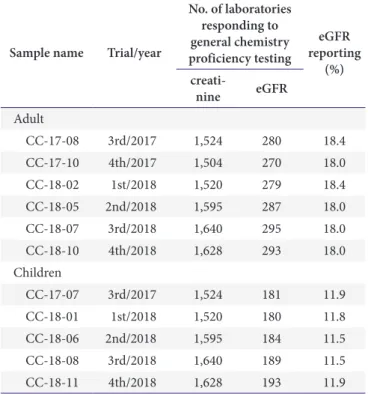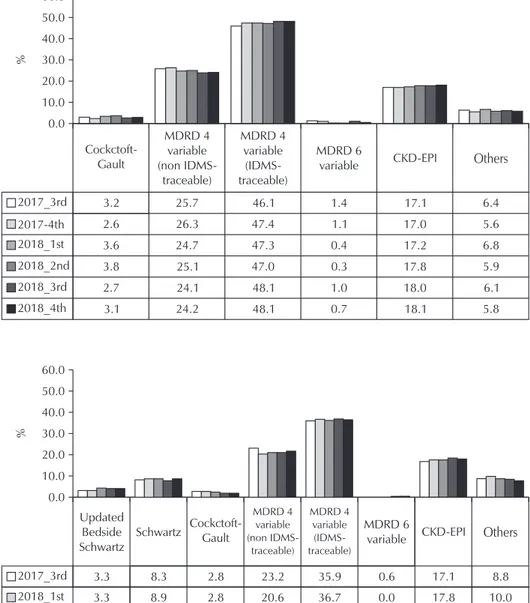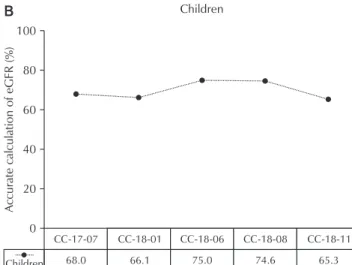서론
전반적인 신기능 평가에 사용하는 대표적 지표는 사구체여 과율(glomerular filtration rate)이다[1]. 사구체여과율을 측
정하는 표준방법은 외인성 표지자인 이눌린을 체내로 주입한 후 소변 이눌린 청소율을 측정하는 것이다[2]. 하지만 이 방법 은 임상검사실에서 일상적인 검사로 시행할 수 없기 때문에 혈 청 크레아티닌 농도로 계산한 추정사구체여과율(estimated
Current Status of Estimated Glomerular Filtration Rate Reporting in Korea
Soo-Kyung Kim 1 , Tae-Dong Jeong 1 , Sholhui Park 1 ,
Young-Wha Lee 2 , and Won-Ki Min 3
1
Department of Laboratory Medicine, Ewha Womans University College of Medicine, Seoul;
2Department of
Laboratory Medicine and Genetics, Soonchunhyang University Bucheon Hospital, Soonchunhyang University College of Medicine, Bucheon;
3
Department of Laboratory Medicine, University of Ulsan College of Medicine and Asan Medical Center, Seoul, Korea
Background: We aimed to investigate the current status of estimated glomerular filtration rate (eGFR) reporting in clinical laboratories for the first time in Korea.
Methods: The eGFR proficiency testing data obtained by the Korean Association of External Quality Assessment Service (KEQAS) from 2017 to 2018 as a pilot project were used. We investigated the proportion of clinical laboratories reporting eGFR who were participants in the KEQAS general chemistry proficiency testing program. The types of equations for calculating the eGFR in adults and children were assessed. We evaluated whether each participant laboratory calculated the eGFR correctly.
Results: About 18% and 12% of laboratories were reporting the eGFR with serum creatinine concentrations for adults and children, respectively. The most common equation for calculating the eGFR in adults was the Modification of Diet in Renal Disease (MDRD) 4 variable (isotope dilution mass spectrometry [IDMS]-traceable), followed by the MDRD 4 variable (non-IDMS-traceable) and Chronic Kidney Disease-Epidemiology Collaboration equation. In children, 9% used the original Schwartz, 4% used the updated Schwartz, and the other laboratories used the same equation as adults. Accurate eGFR was calculated in 76.0%–96.2% of adults and 65.3%–75.0% of children.
Conclusions: Continuous education is needed to report eGFR in clinical laboratories that measure serum creatinine levels. Clinical laboratories need to report the eGFR in accordance with internationally recommended guidelines.
(Lab Med Qual Assur 2019;41:201-206)
Key Words: Creatinine, Glomerular filtration rate, Laboratory proficiency testing
Corresponding author:
Tae-Dong Jeong
Department of Laboratory Medicine, Ewha Womans University College of Medicine, 260 Gonghang-daero, Gangseo- gu, Seoul 07804, Korea Tel: +82-2-6986-3386 Fax: +82-2-6986-3389 E-mail: tdjeong@ewha.ac.kr pISSN: 2384-2458
eISSN: 2288-7261 Received October 15, 2019, Revision received November 6, 2019, Accepted November 12, 2019
glomerular filtration rate)을 대신 사용한다[2].
임상검사실에서 수행하는 모든 검사는 적절한 방법으로 외 부정도관리를 시행할 필요가 있다[3]. 추정사구체여과율의 경 우 국제적으로 권장되는 계산공식을 사용하는지, 보고단위 및 결과보고는 권장되는 방식을 사용하는지, 그리고 정확한 추 정사구체여과율을 계산하여 보고하는지 등 검사와 관련된 전 반적인 질 관리가 필요하다. 대한임상검사정도관리협회에서 2017년 3회차 일반화학검사프로그램부터 2018년 4회차 일반 화학검사프로그램까지 추정사구체여과율 항목을 시범사업으 로 평가하였다. 이전 연구에서 국외 추정사구체여과율 현황에 대한 보고가 있었지만[4,5], 아직까지 국내 임상검사실의 추정 사구체여과율 보고 여부 및 계산공식 종류 등에 대한 연구가 없었다.
본 연구에서 대한임상검사정도관리협회의 추정사구체여과 율 신빙도조사 자료를 기반으로 국내 임상검사실의 추정사구 체여과율 보고현황을 파악하고자 하였다.
재료 및 방법
1. 추정사구체여과율 신빙도조사 자료
국내 임상검사실의 추정사구체여과율 보고현황을 파악하 기 위해 2017년부터 2018년까지 대한임상검사정도관리협회 에서 시행한 일반화학검사 신빙도조사 원시자료를 사용하였 다. 2017년 3회차부터 2018년 4회차까지 총 6회차의 일반화 학검사프로그램 내에 추정사구체여과율 시범사업이 시행되 었고, 매 회차 3개 검체를 사용하였다. 일반화학검사프로그램 에 참여하는 각 기관에서 추정사구체여과율 보고 여부를 선택 하였고, 추정사구체여과율 계산을 위해 프로그램 안내문에 제 공되는 정보(각 검체별 나이, 성별, 인종 등 자료)와 각 참여기 관에서 측정한 크레아티닌 농도 값으로 추정사구체여과율을 계산하도록 하였다. 각 참여기관에서 추정사구체여과율 계산 공식을 선택할 수 있도록 프로그램 안내문에 Modification of Diet in Renal Disease (MDRD) 4 variable (isotope dilution mass spectrometry [IDMS]-traceable) [6], MDRD 4 variable (non IDMS-traceable) [7], MDRD 6 variable [8], Chronic Kidney Disease-Epidemiology Collaboration (CKD-EPI) [9], Cockcroft-Gault [10], Schwartz [11], updated Bedside Schwartz [9], 1B [9] 공식 종류를 제공하 였다(Supplementary Table 1).
2. 자료 분석
대한임상검사정도관리협회 일반화학검사프로그램에 포함
된 크레아티닌검사 결과 회신기관 중 추정사구체여과율 결과 를 함께 회신한 기관을 추정사구체여과율 보고기관으로 정의 하였다. 일반화학검사프로그램 안내문에 제공된 나이 조건에 따른 성인 및 소아의 추정사구체여과율 보고 여부와 각 참여기 관에서 사용하는 추정사구체여과율 계산공식 종류를 조사하 였다. 또한 각 기관에서 사용하는 추정사구체여과율 계산공식 으로 정확하게 추정사구체여과율을 계산했는지 평가하였다.
기관에서 회신한 추정사구체여과율 계산결과가 목표값의 ±1 mL/min/1.73 m
2이내인 경우 추정사구체여과율을 정확하게 계산했다고 판단하였다. 추정사구체여과율 목표값은 각 기관 에서 선택한 계산공식 종류, 크레아티닌 측정값 그리고 추정사 구체여과율 계산을 위해 주어진 정보를 사용하여 연구자들이 계산한 값으로 정의하였다. 계산과정의 오류를 방지하기 위해 연구자 2인이 독립적으로 추정사구체여과율을 계산하여 일치 여부를 확인하였다.
결과
대한임상검사정도관리협회의 일반화학검사프로그램 신빙
Table 1. Response rate of laboratories examining the eGFR for the general chemistry proficiency testing of the Korea Association of Quality Assurance for Clinical Laboratories
Sample name Trial/year
No. of laboratories responding to general chemistry proficiency testing
eGFR reporting creati- (%)
nine eGFR
Adult
CC-17-08 3rd/2017 1,524 280 18.4
CC-17-10 4th/2017 1,504 270 18.0
CC-18-02 1st/2018 1,520 279 18.4
CC-18-05 2nd/2018 1,595 287 18.0
CC-18-07 3rd/2018 1,640 295 18.0
CC-18-10 4th/2018 1,628 293 18.0
Children
CC-17-07 3rd/2017 1,524 181 11.9
CC-18-01 1st/2018 1,520 180 11.8
CC-18-06 2nd/2018 1,595 184 11.5
CC-18-08 3rd/2018 1,640 189 11.5
CC-18-11 4th/2018 1,628 193 11.9
Abbreviation: eGFR, estimated glomerular filtration rate.
도조사에 참여하는 혈청 크레아티닌 농도 검사기관 중 추정사 구체여과율을 계산하여 크레아티닌 농도와 함께 보고하는 기 관 비율이 성인의 경우 약 18%였고, 소아는 약 12%였다. 일 반화학검사프로그램 신빙도조사 회차별 추정사구체여과율 보 고율은 Table 1에 기술하였다.
성인에서 사용하는 추정사구체여과율 계산공식 빈도는 MDRD 4 variable (IDMS-traceable), MDRD 4 variable (non IDMS-traceable), CKD-EPI 순서였다(Fig. 1). 소아 에서 사용하는 추정사구체여과율 계산공식 빈도는 MDRD 4 variable (IDMS-traceable), MDRD 4 variable (non IDMS- traceable), CKD-EPI, Schwartz, updated Schwartz 순서
였다(Fig. 2). 참여기관에서 성인 추정사구체여과율을 정확하 게 계산한 경우는 검체에 따라 76.0% (CC-18-04 검체)부터 96.2% (CC-18-10 검체)까지 분포하였다(Fig. 3A). 소아의 경우 65.3% (CC-18-12 검체)부터 75.0% (CC-18-06 검체) 였다(Fig. 3B).
고찰
본 연구는 국내 임상검사실의 추정사구체여과율 검사현황 을 처음으로 보고한 데 의의가 있다. 대한임상검사정도관리 협회 일반화학검사프로그램의 크레아티닌 검사 참여기관 대
60.0 50.0 40.0 30.0 20.0 10.0
%
Cockctoft- Gault 0.0
MDRD 4 variable (non IDMS-
traceable)
MDRD 4 variable (IDMS- traceable)
MDRD 6
variable CKD-EPI Others
2017_3rd 2017-4th 2018_1st 2018_2nd 2018_3rd 2018_4th
3.2 2.6 3.6 3.8 2.7 3.1
25.7 26.3 24.7 25.1 24.1 24.2
46.1 47.4 47.3 47.0 48.1 48.1
1.4 1.1 0.4 0.3 1.0 0.7
17.1 17.0 17.2 17.8 18.0 18.1
6.4 5.6 6.8 5.9 6.1 5.8
Fig. 1. Equations used to calculate estimated glomerular filtration rate in adults. Abbreviations: MDRD, Modi- fication of Diet in Renal Disease;
IDMS, isotope dilution mass spectro- metry; CKD-EPI, chronic kidney dis- ease epidemiology collaboration.
60.0 50.0 40.0 30.0 20.0 10.0
%
Cockctoft- Gault 0.0
MDRD 4 variable (non IDMS-
traceable)
MDRD 4 variable (IDMS- traceable)
MDRD 6
variable CKD-EPI Others
2017_3rd 2018_1st 2018_2nd 2018_3rd 2018_4th
3.3 3.3 4.3 4.2 4.1
8.3 2.8 23.2 35.9 0.6 17.1 8.8
8.9 2.8 20.6 36.7 0.0 17.8 10.0
8.7 2.7 21.2 36.4 0.0 17.9 8.7
7.9 2.1 21.2 37.0 0.5 18.5 8.5
8.8 2.1 21.8 36.8 0.5 18.1 7.8
Updated Bedside Schwartz
Schwartz
Fig. 2. Equations used to calculate estimated glomerular filtration rate in children. Abbreviations: MDRD, Modification of Diet in Renal Disease;
IDMS, isotope dilution mass spectro-
metry; CKD-EPI, chronic kidney dis-
ease epidemiology collaboration.
비 추정사구체여과율(성인) 시범사업에 회신한 기관은 약 18%였다. 미국 College of American Pathologists (CAP)에 서 주관하는 일반화학검사 외부정도관리(general chemistry proficiency testing survey)에 참여하는 약 5,000여 개 검사실 중 성인의 추정사구체여과율을 보고하는 기관이 2003년 3%
에서 2005년 20%, 2008년 70%, 그리고 2013년에는 90%까 지 점차 증가하였다[5]. 2011년 영국 자료에 의하면, National Health Service 검사실 109개 중 약 43개(49%) 검사실에서 성인의 추정사구체여과율을 보고하였다[4]. 국외 자료와 비교 하면 국내 임상검사실의 성인 추정사구체여과율 보고율이 상 대적으로 매우 낮았다. 본 연구에서 추정사구체여과율 신빙도 조사 시범사업에 결과를 회신한 기관을 추정사구체여과율 보 고기관으로 정의하였기 때문에 추정사구체여과율 보고율이 과소평가되었을 가능성이 있지만, 이를 고려한다고 하더라도 국내 임상검사실의 추정사구체여과율 보고율이 낮다고 판단 된다. 혈청 크레아티닌 농도는 크레아티닌 이외의 다양한 요 인(예: 성별, 나이, 인종, 근육량 등)에 의해 영향을 받기 때문 에 신기능을 정확하게 평가하는 데 제한점이 있다[1]. 따라서 2012 Kidney Disease Improving Global Outcomes (KDIGO) 지침에서 혈청 크레아티닌을 측정하는 검사실에서 추정사구 체여과율을 계산하여 크레아티닌 농도와 함께 보고할 것을 권 장하고 있다[9]. 국내 임상검사실에서도 국제 지침에 따라 추 정사구체여과율을 계산하여 크레아티닌 농도와 함께 보고할 필요가 있다.
반면, 소아의 경우 국내 검사실은 약 12% 가량에서 추정사 구체여과율을 보고하고 있었고, 이는 2017 CAP 조사자료인
9%와 유사하였다[5]. 소아의 경우 Schwartz 또는 updated Schwartz 공식으로 추정사구체여과율을 보고하기 위해 키 (height) 정보가 필요한데, 검사정보시스템을 통해 키 정보를 얻는 것이 제한적인 경우가 많아 성인의 추정사구체여과율 보 고율보다 낮은 것으로 판단된다. 최근 키 정보가 필요 없는 추 정사구체여과율 계산공식이 소개되어 추후 보다 효율적으로 소아의 추정사구체여과율을 보고할 수 있을 것으로 생각된다 [12,13].
2012년 KDIGO 지침에서 권장하는 성인의 추정사구체 여과율 계산공식은 CKD-EPI 공식이며, 소아는 updated Schwartz 및 1B 공식이다[9]. 본 연구에서 성인 추정사구체 여과율을 보고하는 국내 임상검사실의 약 18%에서 CKD-EPI 공식을 사용하고 있었고, 약 70% 가량의 검사실에서는 여러 형태의 MDRD 공식을 사용하고 있었다. 이는 2017년 CAP 자료(CKD-EPI 25%, MDRD 71%)와 유사하였다[5]. 소아 의 경우 국내 임상검사실의 약 4%는 updated Schwartz 공식, 약 9%는 Schwartz 공식을 사용하였고, 이외 검사실은 성인에 서 사용하는 공식을 소아에서 동일하게 사용하였다. 국외 자 료에서는 updated Schwartz 공식 사용이 35%, Schwartz 공 식 사용은 30%였고, 성인의 추정사구체여과율 공식을 사용하 는 기관은 24%였다[5]. 성인의 추정사구체여과율 권장 공식 이 MDRD에서 CKD-EPI 공식으로 변경되었고, 소아의 경우 Schwartz에서 updated Schwartz 또는 1B 공식으로 변경된 것처럼 권장되는 추정사구체여과율 계산공식이 변할 수 있으 므로 각 임상검사실에서는 공신력 있는 기관 또는 단체에서 제 안한 최신 지침을 따르는 것이 권장된다.
CC- 17- 08 100
80
60
40
20
Accurate calculation of eGFR (% )
0
A
CC- 17- 09
CC- 17- 10
CC- 17- 11
CC- 17- 12
CC- 18- 02
CC- 18- 03
CC- 18- 04
CC- 18- 05
CC- 18- 07
CC- 18- 09
CC- 18- 10
CC- 18- 12 Adults
81.8 90.7 89.6 94.8 95.2 79.6 95.3 76.0 80.8 87.1 92.9 96.2 94.5 Adults
B


